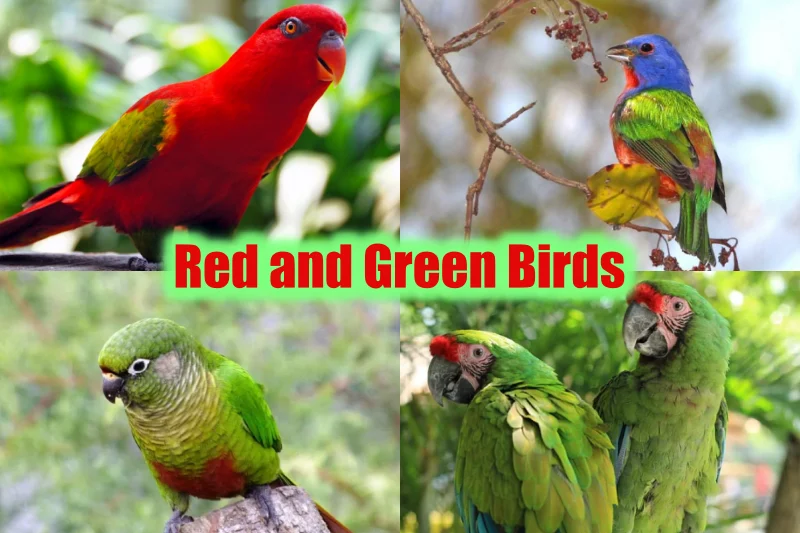If you’ve ever wondered whether there are any red and green birds besides parrots, you’ll be pleasantly surprised to know that many species of birds indeed showcase the beautiful combination of red and green on their bodies.
As we’ve seen and read earlier, in the case of caterpillars, this distinct coloration is not only for aesthetics but also to evade their predators. However, for red and green birds, there hasn’t been a specific threat observed from predatory animals except for humans.
There has been a significant decline in the population of these exquisite birds in the wild due to hunting and capture for the pet trade.
Today, we have compiled a comprehensive list of 15 exquisite red and green birds that you can spot on your next journey to the forest!
15 Exquisite Red and Green Birds: Colorful Plumage
1) Moluccan eclectus
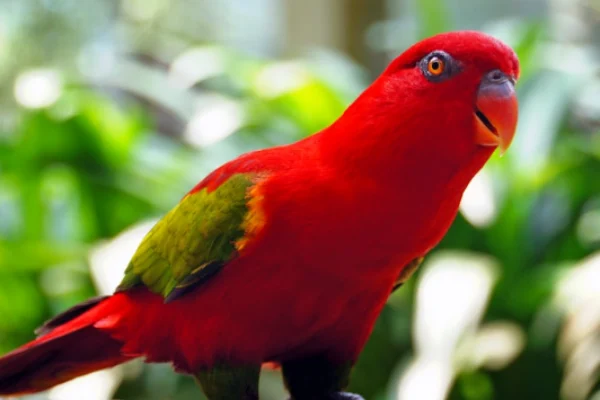
| Scientific Name | Eclectus roratus |
| Size | 35 cm in length |
| Life Span | They may live up to 30 years or more with proper care and attention |
| Geographic Location | Native to the Maluku Islands, situated in the eastern part of Indonesia. |
The males sport a lush emerald green plumage, while the ladies have predominantly vivid red and purple/blue fur.
Often dubbed the “Lady of the Parrots,” this is a parrot species that has a curious history. When European ornithologists first laid eyes on them, they were so taken aback by the dramatic contrast between males and females that they thought they were two entirely separate species!
The adult male’s upper beak displays a transition from orange at its base to yellow towards the tip, while the lower beak is entirely black.
The adult female has an entirely black beak. Adult individuals feature yellow to orange irises, whereas juvenile birds have dark brown to black irises.
2) Tasmanian rosella
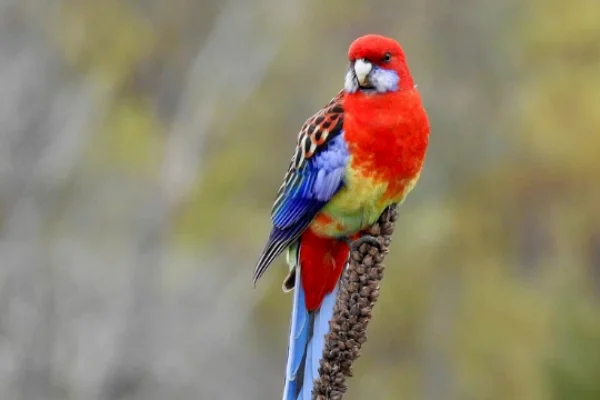
| Scientific Name | Platycercus caledonicus |
| Size | Average length of 11 to 14 inches |
| Life Span | Lives up to 40 years in captivity |
| Geographic Location | Found across Tasmania and the Bass Strait islands |
The green rosella, often nicknamed the “Tasmanian party parrot,” sports eye-catching colors. Its head and underparts are a sunny yellow, complemented by violet-blue cheeks and a red band above its beak.
Green rosellas typically start breeding at the age of two, but occasionally younger birds may also attempt to find nests.
Green rosellas choose tree hollows that are at least 3 feet deep. These hollows can be located high in trees, sometimes as much as 100 feet above the ground for breeding purposes.
Unlike many other birds, the Tasmanian rosella is not a picky eater. It feeds on a diverse menu, from berries and nuts to flower buds and even insect larvae.
3) Red-crowned amazon
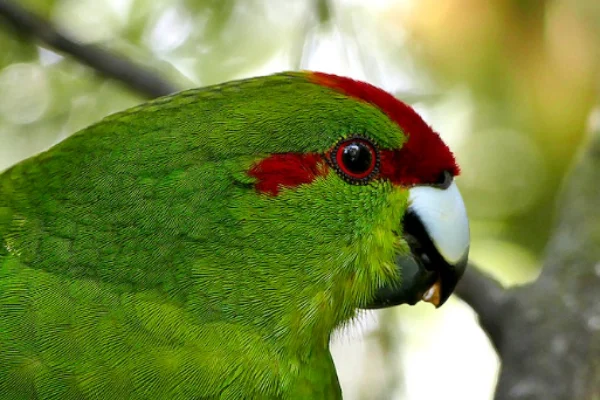
| Scientific Name | Amazona viridigenalis |
| Size | Approximately 11–13 inches |
| Life Span | Around 50 years and some have even reached over 70 years if provided with proper care. |
| Geographic Location | Native to northeastern Mexico |
Red-crowned Amazon has a vibrant green body adorned with a stunning bright red crown on its head.
They can mimic sounds like the microwave or telephone, and some can live over 70 years in captivity if they’re well cared for.
When they’re excited or upset, their eye color changes, with dilating pupils against their bright irises.
In the wild, they form breeding colonies and even mate for life. They seek out tree cavities to raise their chicks and return to the same spot year after year.
4) Red-masked parakeet
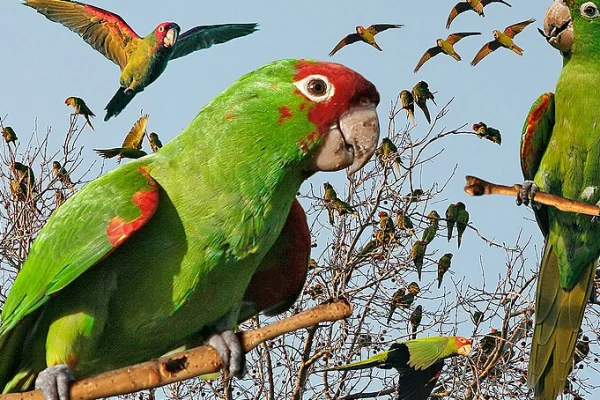
| Scientific Name | Psittacara erythrogenys |
| Size | About 33 cm in length |
| Life Span | Can live for around 15 to 20 years |
| Geographic Location | Southwestern Ecuador and northwestern Peru |
A red-masked parakeet has a bright green outfit with a fiery redhead and an eye-catching pale eye ring.
When they’re young, they sport an all-green look. But as they grow up, they gradually start showcasing their iconic red plumage at around four months of age.
They are known for their chatter and have a distinctive two-syllable, loud, and sometimes harsh call.
5) Red-and-green macaw
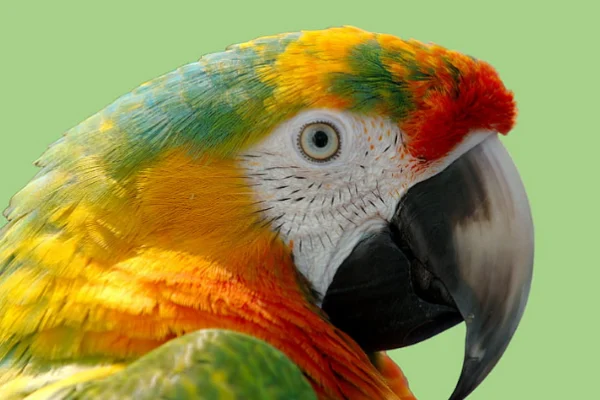
| Scientific Name | Ara chloropterus |
| Size | Around 35 to 37 inches |
| Life Span | They can live for up to 60 to 80 years |
| Geographic Location | Northern and Central America |
The red-and-green macaw has a vibrant mix of bright red and green feathers.
They generally mate for life, forming strong, lifelong bonds.
It’s second in size only to the hyacinth macaw. Adults can reach a whopping 90 to 95 cm.
These magnificent birds have faced habitat loss and capture for the pet trade, causing a decline in their numbers.
6) Great green macaw
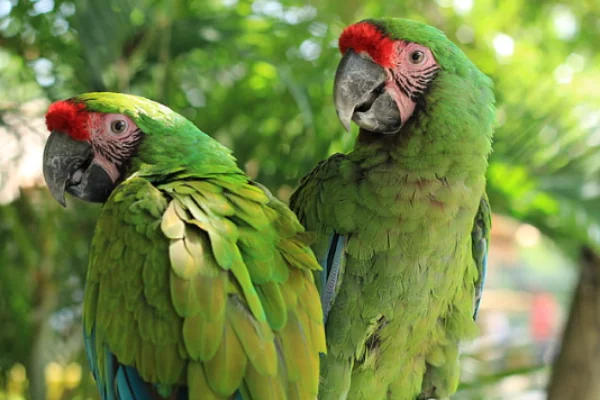
| Scientific Name | Ara ambiguus |
| Size | Average length of 85–90 cm |
| Life Span | 40 to 50 years |
| Geographic Location | Central and South America |
With rich shades of green, a fiery-red crown, and a sprinkle of pale blue on its back and tail feathers, these parrots are like the jungle’s living art.
They’re also among the world’s heaviest parrots! Weighing in at around 1.3 kg (2.9 lbs) and measuring 85–90 cm in length.
Two subspecies of this bird exist: one with a broader distribution from Honduras to Colombia, and another, a more elusive one, residing in the dry forests on Ecuador’s southern Pacific coast.
The Great Green Macaw’s bare facial skin has dark feather lines, especially noticeable in older and female parrots.
7) Green-cheeked parakeet
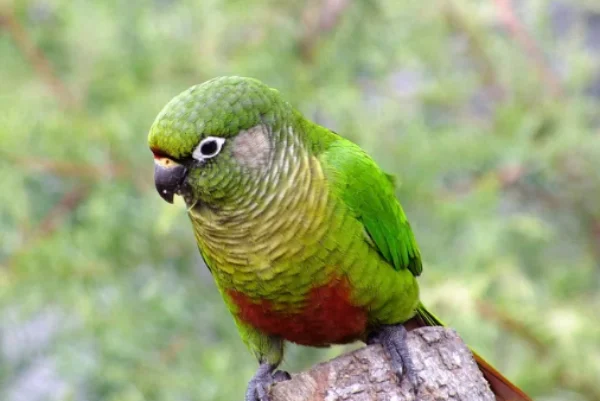
| Scientific Name | Pyrrhura molinae |
| Size | 25 to 26 cm |
| Life Span | 25 to 30 years |
| Geographic Location | Argentina, Bolivia, Brazil, and Paraguay |
The green-cheeked parakeet is truly a masterpiece to behold, featuring green cheeks, a creamy white eye ring, and shades of red, brown, and green.
They are playful, affectionate, and intelligent companions. They can learn tricks, enjoy a good chat, and even get potty trained.
You can spot them in multiple colors: cinnamon ones with lighter, paler coloring, yellow-sided ones with bright-colored breasts, and even pineapple parakeets that combine various colors for a halo effect.
8) European green woodpecker
| Scientific Name | Picus viridis |
| Size | 30–51 cm |
| Life Span | Can live up to 10 years |
| Geographic Location | Europe, spanning from France to Russia and down to Turkey and Iran. |
European green woodpeckers feature a green body with red crowns and black mustache-like marks.
They prefer to feed on ground-level ants, particularly of the Lasius and Formica genera.
You’re more likely to hear their loud and unmistakable calls, known as “yaffling,” before you spot them.
European green woodpeckers are skilled carpenters. They excavate nest holes in various trees, with some holes even being reused for over a decade.
9) Fischer’s lovebird
| Scientific Name | Agapornis fischer |
| Size | 14 cm in length |
| Life Span | 10 to 15 years or more |
| Geographic Location | Native to East-Central Africa, particularly in northern Tanzania. |
Fischer’s lovebird has a lush green coat with golden-yellow necks that transition to fiery oranges with a red beak.
They come in a variety of colors, from striking blues to pale yellows and even albinos!
Lovebirds, including Fischer’s lovebirds, are deeply committed to their partners. When they’re apart, their well-being suffers, emphasizing their strong bond and togetherness.
They inhabit regions around Lake Victoria, and in drought years, they are seen venturing into Rwanda and Burundi in search of moist conditions.
10) Yellow-headed amazon
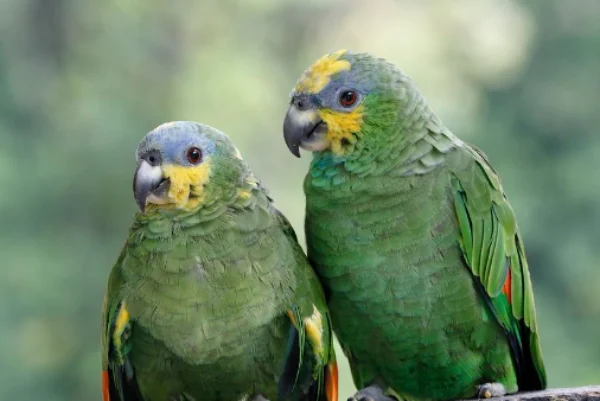
| Scientific Name | Amazona oratrix |
| Size | 15 to 17 inches |
| Life Span | 60 years or more |
| Geographic Location | Mexico and northern Central America |
Yellow-headed Amazons feature vibrant green bodies with flashy yellow heads.
They are known for their operatic voices and an affinity for learning songs.
It’s considered an endangered species due to rampant poaching for the pet trade and habitat destruction.
Their wild numbers have dramatically plummeted from 70,000 to a mere 7,000 in just two decades.
11) Riedel’s eclectus
| Scientific Name | Eclectus riedeli |
| Size | Around 20-25 cm |
| Life Span | 20 to 30 years or more |
| Geographic Location | Native to the Tanimbar Islands |
Riedel’s eclectus are pocket-sized companions compared to their larger relatives the Eclectus roratus.
Males have a bluish touch to their green cheeks and neck, with a yellow band. While, the females have an all-red plumage, with a dash of royal blue in the wings and a generous sprinkle of yellow beneath.
Rarely spotted in captivity, Riedel’s Eclectus parrots are the elusive guests of zoos and bird parks, mainly in Spain and Germany.
12) Glossy ibis
| Scientific Name | Plegadis falcinellus |
| Size | 48–66 cm in length |
| Life Span | 10 to 15 years |
| Geographic Location | Found in warm regions across Europe, Asia, Africa, Australia, and the Atlantic and Caribbean regions of the Americas. |
The glossy ibis has a reddish-brown body and shimmering bottle-green wings.
They’re highly nomadic, flying across the Sahara Desert and venturing as far as East Africa, the Arabian Peninsula, Pakistan, and India.
They communicate with a range of croaks and grunts, and when it’s breeding season, you might even hear a hoarse ‘grrrr’.
13) Painted bunting
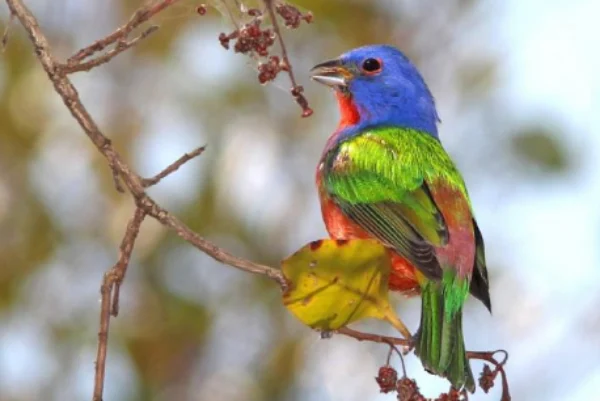
| Scientific Name | Passerina ciris |
| Size | 12–14 cm in length |
| Life Span | Can live for over 10 years |
| Geographic Location | Southeastern United States |
The male painted bunting has a dark blue head, green back, red rump, and underparts. While the females sport green and yellow-green coloration.
These birds may be vocal, but they’re also shy and secretive.
They are migratory birds. They travel from the southeastern United States to as far south as Central America.
14) American purple gallinule
| Scientific Name | Porphyrio martinicus |
| Size | 26–37 cm |
| Life Span | 5 to 6 years |
| Geographic Location | Southeastern United States |
The purple gallinule has a purple-blue coloration that transforms into green and turquoise in the right lighting.
These birds sport bright yellow legs and feet adding a vibrant touch to their colorful appearance.
They travel from the southeastern United States to as far south as Tierra del Fuego and occasionally as far north as Canada.
They are known to fiercely defend their floating nests and care for their young.
15) Broad-billed hummingbird
| Scientific Name | Cynanthus latirostris |
| Size | 8–10 cm |
| Life Span | Typically live for 3 to 5 years |
| Geographic Location | Southwestern United States |
Broad-billed hummingbirds have emerald-green coloration and a striking, bright red bill.
When it’s time to impress a mate, the male hummingbird performs a dazzling “pendulum display.”
It migrates from the southwestern United States to as far south as Mexico when winter arrives.
Unlike the Tasmanian rosella, we discussed before Broad-billed hummingbirds are known to have a picky diet preference. They prefer red and red-and-yellow flowers when it comes to their food choices.
Conclusion
With this, we conclude the article on the 15 exquisite red and green birds. Just because they are red and green, they don’t necessarily have the same characteristics.
While some prefer living in solitude, others like to migrate to find a comfortable place to live. Most of them are migratory birds, and their colorful plumage fills the sky during those seasons.
Stay tuned as we bring you fascinating articles every day!
Also Read:

Hi everyone, my name is Shawna, and I’ve always been fascinated by the fascinating diversity of flora and fauna that our nature has in it. I am currently studying biotechnology and am particularly interested in animal biotechnology, delving into the intricate processes that define their true nature and uniqueness.
